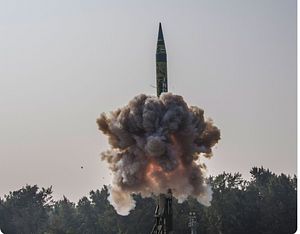India has successfully test fired its most advanced nuclear-capable intercontinental ballistic missile (ICBM), the Agni-V, the Indian Ministry of Defense (MoD) said in a statement. The missile was fired from a canister on a road mobile launcher at Dr Abdul Kalam Island in the Bay of Bengal off the coast of the eastern Indian state of Odisha on December 10.
“The launch operations were carried out and monitored by the Strategic Forces Command (SFC) in presence of Scientists from Defense Research and Development Organization (DRDO) and other associated officials,” the MoD statement reads. The flight performance of the Agni-V was tracked and monitored by radars, tracking instruments and observation stations. According to the MoD, the user trial of the new ICBM was successful. All test objectives were met.
The December 10 test firing constitutes the seventh test launch of the three-stage Agni-V ICBM, officially designated as an intermediate range ballistic missile (IRBM), and the third launch in 2018. The last test of the missile took place on June 3. A previous test occurred on January 18. In both instances, the ICBM was launched in deliverable configuration from a hermetically sealed canister mounted on a mobile transporter erector launcher.
The missile was fired in a similar configuration in December 2016 and January 2015. The former launch included testing the missile for its full range. Two other tests that took place in April 2012 and September 2013 respectively, involved the launch of the Agni-V in ‘open configuration.’ The Agni-V is expected to be inducted into service in the coming months. (Earlier media reports suggested a December 2018 induction date.) An operational deployment of the new ICBM would require at least two additional test firings by the SFC.
Development of the Agni-V began in 2008. The ICBM features indigenously designed navigation and guidance systems including a ring laser gyroscope based inertial navigation system. The missile has been primarily developed as a strategic nuclear deterrent against China. As I noted previously:
While previous nuclear-capable missiles of the series (Agni-I, Agni-II, and Agni-III) were developed to offset Pakistan’s nuclear arsenal, the Agni-IV, [and] Agni-V (…) given their longer ranges, are designed to provide a credible nuclear deterrent against China.
Additionally, I explained:
The Agni-V, a three-stage solid fueled missile, has an approximate range of 5,500-5,800 kilometers [the exact range remains classified, but it is assumed that the missile has a range of 6,000-7,500 kilometers], and can carry a 1,500-kilogram (3,300-pound) nuclear warhead. India has reportedly also been working on multiple independently targetable reentry vehicles (MIRV) for the Agni-V in order to ensure a credible second-strike capability.
The Agni-V’s increased accuracy could pose a problem for long-term strategic stability in South Asia. The missile’s reduced launch time, paired with India’s burgeoning maneuverable reentry vehicle (MaRV) and MIRV technology, can reduce decision-making time in crisis situations and invite miscalculation.
































